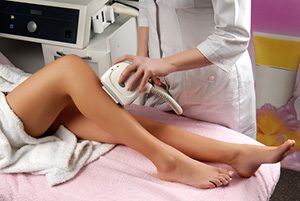Laser Hair Removal
 Laser hair removal is a convenient non-invasive method for permanently reducing or removing unwanted facial and body hair. It leaves the skin looing smoother and silkier than waxing, electrolysis and razors and is a gentle technic that can treat large areas effectively with minimal discomfort and with no downtime. Today, laser hair removal is one of the most common aesthetic procedures performed in the United States
Laser hair removal is a convenient non-invasive method for permanently reducing or removing unwanted facial and body hair. It leaves the skin looing smoother and silkier than waxing, electrolysis and razors and is a gentle technic that can treat large areas effectively with minimal discomfort and with no downtime. Today, laser hair removal is one of the most common aesthetic procedures performed in the United States
How Laser Hair Removal Works
Laser emits a specific beam of light at a wavelength that targets the melanin in the hair at the hair growth center which is the hair bulb papilla region. Papilla is a large structure at the base of the hair follicle that nourishes the hair follicles by supplying nutrients and oxygen to the bottom layer of the epidermis cell. The bulge of a hair follicle is essential in the regeneration of hair as it supplies the hair follicle with new cells. For hair to stop growing back these areas need to be seriously damaged.
There are 3 phases of hair growth. Phase 1 is the anagen, which is the active growth. Phase 2 is the catagen which is transition phase and the telogen, which is the resting phase. Laser targets only the active phase of hair growth. Not all hairs are in the anagen phase at the same ime, therefore several treatments may be needed for complete hair removal.
What to Expect During Laser Hair Removal
You should also avoid sun exposure for six weeks before and after treatment. Sun exposure makes laser hair removal less effective and makes complications more likely. The area to be treated needs to be shaved the day before the procedure.
Pinkness or redness are usually the end point we are looking for during the laser hair removal treatment.
You may schedule your next treatment four to six weeks later. At Gentle Aesthetics Touch, we used the latest state of the art laser machine from Aerolase, you may need to get treatments for 4-6 times until hair stops growing.
Recovery and Risks
For a day or two afterward, the treated area of your skin will look and feel like it’s sunburned. Cool compresses and moisturizers may help.
Over the next month, your treated hair will fall out. Wear sunscreen for the following month to help prevent temporary changes in the color of the treated skin.
Blisters are rare but are more likely in people with darker complexions. Other potential side effects are swelling, redness, and scarring. Permanent scarring or changes in skin color are rare.

Follow Us:
![]()
![]()
![]()
![]()
![]()
